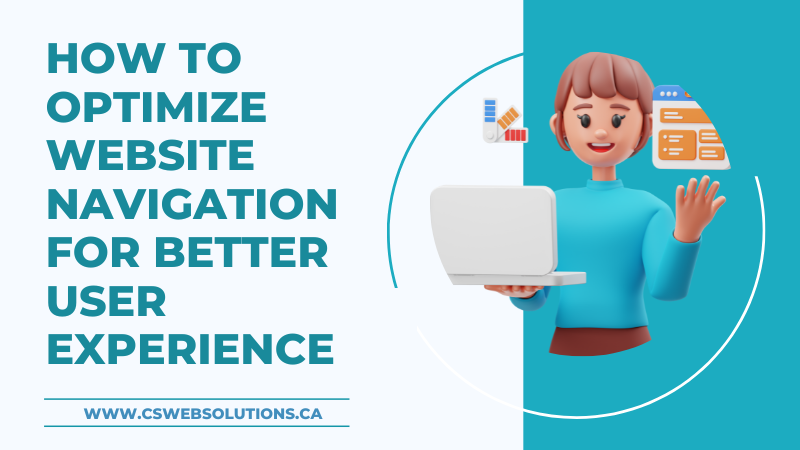Website navigation is a component of user interface design that helps website visitors find the required content. These components can incorporate text links, buttons, and menus.
A survey by Top Design Firms indicates that 38% of website visitors check website navigation links and layouts when looking at a site for the first time. If your website’s navigation menu is not organized properly, visitors may have trouble locating desired pages and accessing the information they need.
This considerably downgrades UI/UX design experience and drives away your online traffic to other websites. This may damage your search engine rankings and hurt the financial performance of your business by increasing your bounce rate, decreasing time spent on the site, and decreasing your conversion rates.
Professional web design, custom web design, and strategically designed landing page design have precisely crafted website navigation. Need help to improve your website’s navigation? Contact CS Web Solutions, a leading web design company in Mississauga.
Types of Website Navigation
Website Navigation can be differentiated in two distinct ways depending on how the menu and the links are presented in substance and style. The first focuses on what kind of menu headers are created across web pages and the second focuses on how the headers are placed on the web page layout.
Depending on whether the navigation links are standardized/ customized menu or embedded in the main text, website navigation can be categorized as follows:
- Global Website Navigation: The menu and links on a global website are the same on all of the website’s pages. This is how many contemporary menus are designed.
- Hierarchical Website Navigation: With hierarchical navigation, the menus adjust to the requirements of each page. Such custom web design elements can be seen in content-based websites and newspapers.
- Local Website Navigation: Local website navigation refers to embedded links that are incorporated within the content itself. The links in the article allow readers to delve deeper into specific topics by clicking on relevant words instead of providing extensive explanations within the article itself. E-commerce websites use this navigation method to link product listings to suitable categories.
Contact experts at CS Web Solutions, your local web design company in Mississauga to get responsive web design services.
The five primary methods of website navigation as per design layout are as follows:
- Horizontal Navigation Bar:
The top-level links are shown horizontally next to one another. The most crucial web pages are typically included in the header bar.
- Dropdown Navigation Menu:
Dropdown menus allow nesting your products under various hierarchical tiers. The top-level navigation uses the most significant links. A menu with more links appears when the mouse lingers over one such link.
- Hamburger Navigation Menu:
Often seen in mobile-friendly websites, this kind of navigation consists of an icon that reveals a menu when clicked. The menu consists of top-level links. These links can be expanded for respective sub-categories.
- Vertical Sidebar Navigation Menu:
This menu offers a series of links layered on top of one another and placed on each side of the page. On internal pages where visitors require more specialized options and internal links to improve their buying experience, sidebar navigation is particularly helpful.
- Footer Navigation Menu:
The majority of the site’s pages are normally linked in footer navigation along a horizontal navigation bar. It’s a good idea to provide lots of options so that the visitors can browse to the bottom of the page to locate more links if they can’t find what they’re looking for in the header.
Improving Website Navigation
The following tips and principles will help you enhance your website navigation for optimal results:
- Page Structure and Navigation Menu:
Plan out your website’s navigation and page structure before you even begin producing any content. Create a well-organized and simple-to-use navigation menu. This will ensure that your visitors can navigate your site easily. You may develop prototypes of the website’s UI and UX by using a sitemap creator. For more customized layouts you may consider seeking professional help from web design services that help create your website for your specific needs.
- Landing Page Design:
Since landing pages play a huge role in converting online traffic, you should design them with simplicity and avoid crowding them with distracting elements.
- Standards and Consistency:
Familiarity is key for a successful UI/UX design so that website navigation is smooth and intuitive. Therefore, follow accepted standards for crucial design aspects, such as where to position your menu and which icons to use. Also, be consistent with your design elements and layout across web pages to minimize confusion for website users.
- Responsive Web Design with Mobile-Friendly Menus:
Since mobile devices now account for the majority of web traffic, mobile-friendly web design is essential. Optimize your website’s navigation for mobile devices. Use responsive design techniques to ensure menus and navigation elements are accessible and user-friendly on various screen sizes. For instance, make sure to use expandable mobile menus and avoid clutter.
- User Testing and Feedback: User testing and gathering feedback on the website’s navigation is an integral part of the professional web design process. Observe how users interact with the site and make improvements based on their preferences and pain points. One powerful tool to examine how users navigate your website is the Users Flow Report by Google Analytics. It shows user paths through the various web pages in a graphical form.
Conclusion
Finding the information people need on a website should be quick and simple with the help of website navigation. Users should easily navigate from page to page via the navigation menus. Good website navigation improves UX design, boosts engagement, and eventually aids in achieving the website’s objectives.
Mobile-friendly web design must also factor in current trends like increased mobile phone usage and strategize design and layout around that. Lastly, experts should adopt current best practices in the field and largely stick to standardized design elements to enhance user familiarity.

